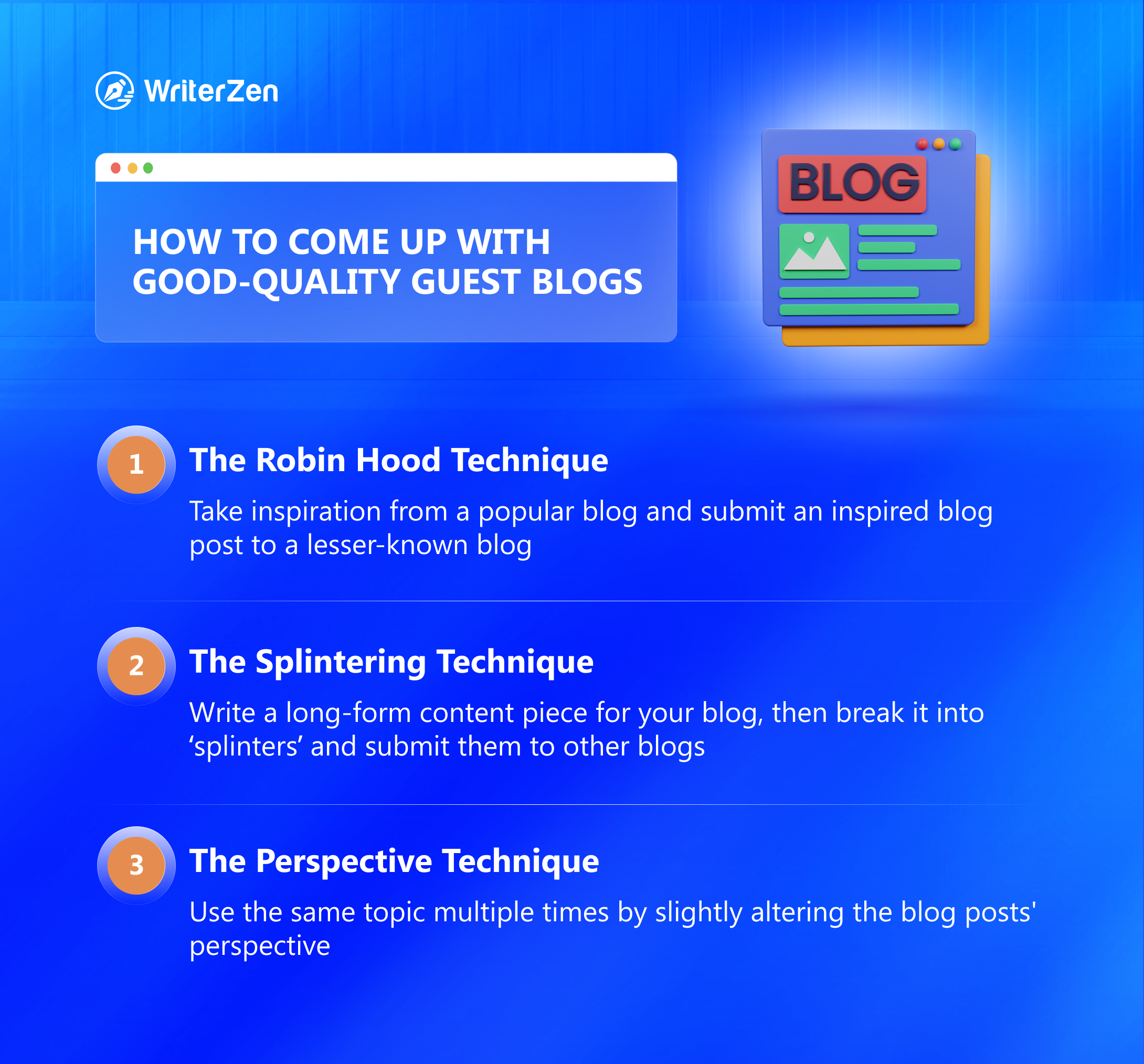What Is Guest Blogging?
As the name suggests, guest blogging (also known as guest posting) is when a blogger creates content for a blog that doesn’t belong to him. In other words, when a website owner invites a guest blogger to create content for their blogs, it is known as guest blogging.
Submitting a guest post for a website owner gives you access to a new audience you can probably use to your advantage.
Why Is Guest Blogging Important for SEO?
Increases Search Visibility
Guest blogging can help increase the visibility of a website or blog in search engine results pages (SERPs) by providing external links to other websites or blogs. When you contribute guest posts to high-quality blogs in your niche, you can build backlinks to your own site, which can improve your search engine rankings and drive more organic traffic to your site.
Drives Targeted Traffic
By creating content that is centered around specific topics and keywords, guest bloggers can have the ability to attract potential customers or readers. With a focused approach, guest posts can effectively target the right audience, increasing the likelihood of converting visitors into loyal subscribers or valuable customers.
You can also use guest blogging to build relationships with other bloggers and influencers in your industry. This can help you to create a network of people who can help promote your content and drive even more traffic to your website.
Enhances Brand Awareness
When a guest blogger shares content on their own blog or website, they are exposing more people to the website or blog, which can create more recognition for the brand. It also helps increase the website's authority in its field, allowing it to share valuable content with a wider audience and further enhance the brand reputation.
Furthermore, it can help to build relationships with readers as they become more familiar with the website's content.
How to Find Guest Blogging Opportunities?
Suppose you decide that you want to submit a guest post for a website. Given that you already have your blog page with a specific niche, you first need to find a web page or site that will accept your guest post.
For this, you will have to create a long list of target websites that you will approach for guest blogging. Here are a few techniques that you can use to find guest post opportunities:

Try Google Search (or Any Other Search Engine)
The first resource you can use to find guest blogging opportunities is Google. You must use the correct search terms or target keywords for guest posting. We have listed some of the standard search terms that you can use to find guest blogging opportunities on Google:
-
[Your niche/topic] “Write for us.”
-
[Your niche/topic] “Guest Post.”
-
[Your niche/topic] “Guest post offers.”
-
[Your niche/topic] “Guest writer.”
-
[Your niche/topic] “Guest writer needed.”
-
[Your niche/topic] “Suggest an idea.”
-
[Your niche/topic] “Suggest a blog post.”
-
[Your niche/topic] “Written by.”
-
[Your niche/topic] “Guest post was written by.”
-
[Your niche/topic] “contributor guidelines.”
-
[Your niche/topic] “guest blog post wanted.”
-
[Your niche/topic] “blogger wanted.”
-
[Your niche/topic] “writer wanted.”
-
[Your niche/topic] “article wanted.”
-
[Your niche/topic] “blog post needed.”
-
[Your niche/topic] “article needed.”
-
[Your niche/topic] “writer needed.”
-
[Your niche/topic] “accepting guest posts.”
-
[Your niche/topic] “post written by" "[famous writer].”
-
[Your niche/topic] “become a guest writer/blogger.”
-
[Your niche/topic] “guest author.”
-
[Your niche/topic] “submit an article.”
Other than guest blogging opportunities, these keywords can also help you find websites with some guest blogs. If these websites have accepted guest posts earlier, they might agree to abide by your guest post. Hence, you can contact the websites for guest blogging opportunities.
Make Use of Social Media Platforms
First, do not try to find guest blogging opportunities on Facebook and Instagram. It might work out for you if you are connected with individuals or groups involved in guest blogging on these platforms. However, these platforms are not the best for finding guest blogging opportunities from scratch. The leading social media platform that you need to target is LinkedIn.
On LinkedIn, you can simply type the search term ‘guest posting’ or ‘guest blogging’ or anything relevant in the search bar. Then, you can view all the posts that contain these search terms.
You might have to scroll down a few pages before you get a relevant guest blogging opportunity. You can also utilize this platform to search competitors’ pages to see if they are looking for a guest blogger.
Finally, you can also write a LinkedIn post to express your interest in writing a guest post. Make sure you write all the essential details like the niche/topic in your mind, experience, etc., and mention relevant hashtags like #guestblogging for increased searchability of your LinkedIn post.
You can also try to join online communities of bloggers on various social media platforms and request guest blogging opportunities.
Track Your Competitor’s Backlinks
Find out which of your competitors are successful guest bloggers, find out what they are doing, and try to do the same thing better. You can analyze your competitor’s backlinks to find guest blogging opportunities. To do this, you can use online tools such as Ahrefs, SEMRUSH, etc.
Ahrefs Site Explorer and SEMRUSH can help you explore all the backlinks on your competitor’s website. You have to copy the link of your competitor’s website and paste it into the search bar to get the results.
This technique works best for small to medium websites that have a comparatively lower number of backlinks. If you try to analyze a trendy website such as HubSpot.com, you will find thousands of backlinks that will make your task very tedious.
Connect with Influencers/Websites/Competitors Directly
If you want to write a guest blog for an online influencer, blog page website, or competitor website, you can contact them directly to set up a collaboration meeting. This method might not always be fruitful, but it is the simplest.
You need to connect with websites and send them cold messages and emails explaining the scenario. However, you must know a few factors to keep in mind while composing the messages:
-
Do not write a generic message.
-
Mention the benefits the website or the influence will get from this collaboration.
-
Keep it concise.
-
Research well about the message recipient well and make the message a little personal.
-
Proofread the message before pressing the send button.
If you compile the results from all these sources and create a spreadsheet with the blog details that allow guest blogging, you will probably have thousands of viable blog options from your niche. But now you must filter the blogs and create good quality guest content.
How to Come Up with Good-quality Guest Blogs and Articles in Less Time?
After learning how to find relevant guest blogging opportunities, it's time to execute quality guest posting for all of them. Ideally, you will need to submit 3-5 guest posts per week to make a considerable difference in the SEO optimisation of your website. Therefore, you must write these guest blogs as fast as possible.
Below are some well-known copywriting techniques to come up with high-quality content in a short period.

The Robin Hood Technique
After your search for guest blogging websites, you have a long list containing thousands of blogs in your datasheet. Now, you need to filter the blogs in terms of popularity with the help of relevant metrics (such as the domain rating system).
Now, you can choose a blog with high popularity from your niche and analyze it using online tools. It will pull up results such as the number of social media shares, backlinks, and organic traffic for each blog post. Then, choose the blog post of your choice and try to submit it to a less popular blog.
Essentially, you have taken inspiration from a popular blog and submitted an inspired blog post to a lesser-known blog. It seems similar to the story of Robin Hood, doesn’t it?
The Splintering Technique
Some of the blogs in your datasheet might contain lengthy content pieces. These long-form content are generally indexed with a table of contents for ease of navigation to subheadings and quick readability.
You can choose any subheadings from this long-form content and create standalone blog posts. Then, you can post these ‘splintered’ blog posts as guest posts.
Another two-step strategy that you can follow is:
-
Step 1: Write a long-form content piece for your blog.
-
Step 2: Break your long content piece into ‘splinters’ and post each splinter as a guest post to other blogs.
This way, your blog will have the main article, and you will have submitted multiple guest blog posts to various websites. It is strongly advised that you don't copy and paste the same part of your blog post to another blog; you must write it in other words.
The Perspective Technique
It is challenging to develop a brand new content idea every time. You can use the same topic multiple times by slightly altering the blog posts' perspective.
For instance: Suppose you created a guest blog post titled ‘How to raise funds for startups.’ You can alter the perspective and come up with various blog post titles, such as:
-
How to raise funds for local businesses
-
How to raise funds for non-profit organizations
-
How to raise funds for small businesses
-
How to raise funds for online businesses
-
How to raise funds for entrepreneurs
Each article might differ in the main content body, but each blog post's main idea and structure would be somewhat similar. It will save you a lot of time and effort that you use for other productive tasks.
Combination of All the Three Techniques
You can also make use of all three techniques mentioned above in the same order to create the best guest posting workflow:
-
Step 1: The Robin Hood Technique - Find the most popular blog post and create a new long-form content piece using it as inspiration.
-
Step 2: The Splintering Technique - Divide the long-form content piece into multiple blog posts with the subheading of the long-form content as the heading of the resulting blog posts.
-
Step 3: The Perspective Technique - Cover the resulting blog posts from step 2 from different perspectives.
How to Make Sure that Your Guest Blogging Venture is Successful?
Many problems might arise in your guest blogging journey, such as:
-
Websites may reject your guest blog posts
-
The backlinks you added in your guest post might not bring as many positive results as you had hoped.
-
The website may remove the backlinks to your website without informing you.
We have listed some clever tips that can help you solve these problems:
Put Some Effort into Writing High-quality Content
If you want most of your guest blog posts to be accepted by blog owners, you must ensure they are of good quality. It is predominantly true for industry-leading blog owners because they care a lot about their quality and reputation.
So, producing quality content should always be the center of your strategy.
Pitch Your Collaboration Idea to a Lot of Blogs and Website Owners
Submitting your guest blog post to successful websites is not a fast process, and you might have to wait for a long period for acceptance of your blog post or even to get a reply to the initial collaboration request.
Hence, it is highly recommended to pitch your collaboration idea to as many blog owners as possible. That way, even if a blog owner doesn’t reply or reject your guest articles, it wouldn’t make a lot of difference since you have a lot of other collaboration initiatives in the pipeline.
Link Your Other Published Guest Posts to Restrictive Blogs and Websites
Generally, website owners are self-indulgent in promotional links. It is possible that the blog owners accept your invitation to collaborate but will not allow you to link your website in the guest posts.
To make the best of this situation, you can link the current guest blog post to your older guest articles that relate to your website, and it will create a tiered link structure.
Try to Write Guest Posts for New Websites
After you have already submitted a guest blog post for a website, it is easier to collaborate with the same website again rather than new websites. But we recommend you try submitting guest posts for new websites with each post to gain access to new target audiences.
Final Thoughts
In conclusion, guest blogging remains a valuable and effective strategy for SEO, particularly when it comes to generating high-quality backlinks at scale. Remember to prioritize quality over quantity, ensuring that each guest blog post provides genuine value to readers and establishes your authority in the industry.
With consistent effort and a strategic approach, which is already outlined in this blog, guest blogging can play a pivotal role in boosting your SEO efforts and driving targeted traffic to your website.
So, start exploring guest blogging opportunities today and watch your online presence soar.















